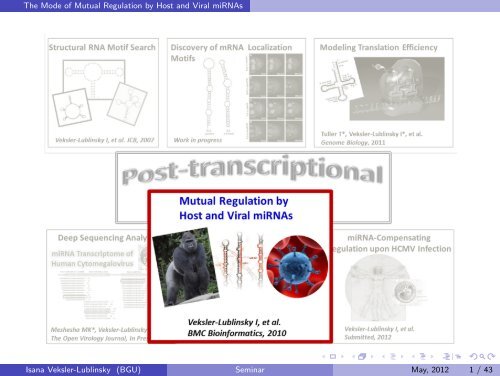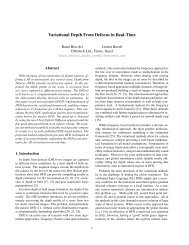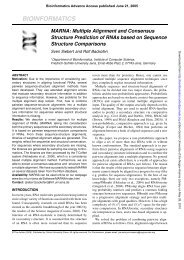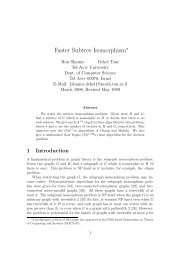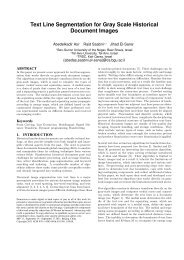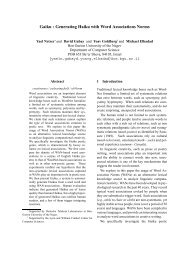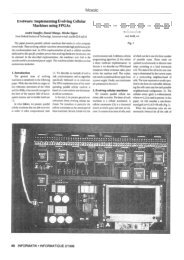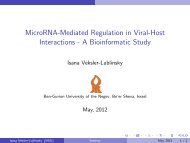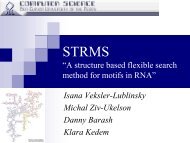A Bioinformatic Study - the Department of Computer Science
A Bioinformatic Study - the Department of Computer Science
A Bioinformatic Study - the Department of Computer Science
Create successful ePaper yourself
Turn your PDF publications into a flip-book with our unique Google optimized e-Paper software.
The Mode <strong>of</strong> Mutual Regulation by Host and Viral miRNAs<br />
Isana Veksler-Lublinsky (BGU) Seminar May, 2012 1 / 43
The Mode <strong>of</strong> Mutual Regulation by Host and Viral miRNAs<br />
Isana Veksler-Lublinsky (BGU) Seminar May, 2012 2 / 43
The Mode <strong>of</strong> Mutual Regulation by Host and Viral miRNAs<br />
<strong>Bioinformatic</strong> Limitation<br />
Target Prediction is noisy:<br />
an excess <strong>of</strong> predicted targets for<br />
each miRNA (some are False<br />
Positives).<br />
Isana Veksler-Lublinsky (BGU) Seminar May, 2012 2 / 43
The Mode <strong>of</strong> Mutual Regulation by Host and Viral miRNAs<br />
<strong>Bioinformatic</strong> Limitation<br />
Target Prediction is noisy:<br />
an excess <strong>of</strong> predicted targets for<br />
each miRNA (some are False<br />
Positives).<br />
<strong>Bioinformatic</strong> Question<br />
Can we combine target prediction with new regulation scenarios and<br />
additional information sources, to narrow <strong>the</strong> target genes list to more<br />
reliable candidates?<br />
Isana Veksler-Lublinsky (BGU) Seminar May, 2012 2 / 43
The Mode <strong>of</strong> Mutual Regulation by Host and Viral miRNAs<br />
Biological Background<br />
Multiplicity: One miRNA can target more than one gene.<br />
Cooperativity: One gene can be targeted by more than one miRNA.<br />
A wider view <strong>of</strong> <strong>the</strong> regulation process, in which we consider miRNAs<br />
as part <strong>of</strong> a larger regulatory network, ra<strong>the</strong>r than <strong>the</strong> narrow view <strong>of</strong><br />
single miRNA-single gene, may yield more robust results.<br />
Isana Veksler-Lublinsky (BGU) Seminar May, 2012 2 / 43
The Mode <strong>of</strong> Mutual Regulation by Host and Viral miRNAs<br />
Our Hypo<strong>the</strong>sis<br />
Viral miRNAs might take advantage <strong>of</strong> <strong>the</strong> regulation that already exists in<br />
<strong>the</strong> cell, to increase <strong>the</strong> translational repression to <strong>the</strong> virus benefit.<br />
Isana Veksler-Lublinsky (BGU) Seminar May, 2012 2 / 43
The Mode <strong>of</strong> Mutual Regulation by Host and Viral miRNAs<br />
Our Hypo<strong>the</strong>sis<br />
Viral miRNAs might take advantage <strong>of</strong> <strong>the</strong> regulation that already exists in<br />
<strong>the</strong> cell, to increase <strong>the</strong> translational repression to <strong>the</strong> virus benefit.<br />
New <strong>Bioinformatic</strong> Goal<br />
Explore <strong>the</strong> combined effect <strong>of</strong> host and viral miRNAs on host pathways<br />
(Cooperating mode <strong>of</strong> regulation).<br />
Isana Veksler-Lublinsky (BGU) Seminar May, 2012 2 / 43
The Mode <strong>of</strong> Mutual Regulation by Host and Viral miRNAs<br />
Our Hypo<strong>the</strong>sis<br />
Viral miRNAs might take advantage <strong>of</strong> <strong>the</strong> regulation that already exists in<br />
<strong>the</strong> cell, to increase <strong>the</strong> translational repression to <strong>the</strong> virus benefit.<br />
New <strong>Bioinformatic</strong> Goal<br />
Explore <strong>the</strong> combined effect <strong>of</strong> host and viral miRNAs on host pathways<br />
(Cooperating mode <strong>of</strong> regulation).<br />
Combine target prediction results with<br />
Host and viral miRNA expression in cells infected with virus,<br />
Biological pathway annotations<br />
Isana Veksler-Lublinsky (BGU) Seminar May, 2012 2 / 43
The Mode <strong>of</strong> Mutual Regulation by Host and Viral miRNAs<br />
The Bi-Targeting Algorithm<br />
Goal: To find groups <strong>of</strong> genes that are mutually regulated by <strong>the</strong> same<br />
host and viral miRNAs - modules.<br />
Isana Veksler-Lublinsky (BGU) Seminar May, 2012 3 / 43
The Mode <strong>of</strong> Mutual Regulation by Host and Viral miRNAs<br />
Representing <strong>the</strong> miRNA-mRNA Relations<br />
Using target prediction and/or experimental data.<br />
Isana Veksler-Lublinsky (BGU) Seminar May, 2012 4 / 43
The Mode <strong>of</strong> Mutual Regulation by Host and Viral miRNAs<br />
Constraints<br />
No. <strong>of</strong> host miRNAs ≥ qh<br />
No. <strong>of</strong> viral miRNAs ≥ qv<br />
No. <strong>of</strong> targeted mRNAs ≥ qg<br />
Enrichment p-value < p<br />
Isana Veksler-Lublinsky (BGU) Seminar May, 2012 5 / 43
The Mode <strong>of</strong> Mutual Regulation by Host and Viral miRNAs<br />
Constraints<br />
No. <strong>of</strong> host miRNAs ≥ qh<br />
No. <strong>of</strong> viral miRNAs ≥ qv<br />
No. <strong>of</strong> targeted mRNAs ≥ qg<br />
Enrichment p-value < p<br />
Isana Veksler-Lublinsky (BGU) Seminar May, 2012 5 / 43
The Mode <strong>of</strong> Mutual Regulation by Host and Viral miRNAs<br />
The task <strong>of</strong> finding miRNA-mRNA modules is formulated as bi-clustering<br />
problem.<br />
(Yoon and Micheli, 2005; Peng et al, 2009)<br />
Isana Veksler-Lublinsky (BGU) Seminar May, 2012 6 / 43
The Mode <strong>of</strong> Mutual Regulation by Host and Viral miRNAs<br />
The task <strong>of</strong> finding miRNA-mRNA modules is formulated as bi-clustering<br />
problem.<br />
(Yoon and Micheli, 2005; Peng et al, 2009)<br />
⋄ The miRNA set is composed <strong>of</strong> human and viral miRNAs.<br />
⋄ A new type <strong>of</strong> clustering is needed.<br />
Isana Veksler-Lublinsky (BGU) Seminar May, 2012 6 / 43
The Mode <strong>of</strong> Mutual Regulation by Host and Viral miRNAs<br />
Bi-Targeting Algorithm<br />
The general idea:<br />
Enumerate groups <strong>of</strong> genes that are mutually targeted by both host and<br />
viral miRNAs. The genes are taken from a pathway/process.<br />
Isana Veksler-Lublinsky (BGU) Seminar May, 2012 7 / 43
The Mode <strong>of</strong> Mutual Regulation by Host and Viral miRNAs<br />
Bi-Targeting Algorithm<br />
The general idea:<br />
Enumerate groups <strong>of</strong> genes that are mutually targeted by both host and<br />
viral miRNAs. The genes are taken from a pathway/process.<br />
Using <strong>the</strong> modules<br />
The genes in <strong>the</strong> modules may serve as candidates for experimental<br />
target validation.<br />
The modules may help understanding <strong>the</strong> role <strong>of</strong> miRNAs in host-viral<br />
interactions.<br />
Isana Veksler-Lublinsky (BGU) Seminar May, 2012 7 / 43
The Mode <strong>of</strong> Mutual Regulation by Host and Viral miRNAs<br />
Bi-Targeting Algorithm<br />
The general idea:<br />
Enumerate groups <strong>of</strong> genes that are mutually targeted by both host and<br />
viral miRNAs. The genes are taken from a pathway/process.<br />
Isana Veksler-Lublinsky (BGU) Seminar May, 2012 8 / 43
The Mode <strong>of</strong> Mutual Regulation by Host and Viral miRNAs<br />
Bi-Targeting Algorithm<br />
The general idea:<br />
Enumerate groups <strong>of</strong> genes that are mutually targeted by both host and<br />
viral miRNAs. The genes are taken from a pathway/process.<br />
Isana Veksler-Lublinsky (BGU) Seminar May, 2012 8 / 43
The Mode <strong>of</strong> Mutual Regulation by Host and Viral miRNAs<br />
Bi-Targeting Algorithm<br />
The general idea:<br />
Enumerate groups <strong>of</strong> genes that are mutually targeted by both host and<br />
viral miRNAs. The genes are taken from a pathway/process.<br />
Isana Veksler-Lublinsky (BGU) Seminar May, 2012 8 / 43
The Mode <strong>of</strong> Mutual Regulation by Host and Viral miRNAs<br />
Bi-Targeting Algorithm<br />
The general idea:<br />
Enumerate groups <strong>of</strong> genes that are mutually targeted by both host and<br />
viral miRNAs. The genes are taken from a pathway/process.<br />
Isana Veksler-Lublinsky (BGU) Seminar May, 2012 8 / 43
The Mode <strong>of</strong> Mutual Regulation by Host and Viral miRNAs<br />
Bi-Targeting Algorithm<br />
The general idea:<br />
Enumerate groups <strong>of</strong> genes that are mutually targeted by both host and<br />
viral miRNAs. The genes are taken from a pathway/process.<br />
Isana Veksler-Lublinsky (BGU) Seminar May, 2012 8 / 43
The Mode <strong>of</strong> Mutual Regulation by Host and Viral miRNAs<br />
Bi-Targeting Algorithm<br />
The general idea:<br />
Enumerate groups <strong>of</strong> genes that are mutually targeted by both host and<br />
viral miRNAs. The genes are taken from a pathway/process.<br />
Isana Veksler-Lublinsky (BGU) Seminar May, 2012 8 / 43
The Mode <strong>of</strong> Mutual Regulation by Host and Viral miRNAs<br />
Bi-Targeting Algorithm<br />
The general idea:<br />
Enumerate groups <strong>of</strong> genes that are mutually targeted by both host and<br />
viral miRNAs. The genes are taken from a pathway/process.<br />
Isana Veksler-Lublinsky (BGU) Seminar May, 2012 8 / 43
The Mode <strong>of</strong> Mutual Regulation by Host and Viral miRNAs<br />
Bi-Targeting Algorithm<br />
The general idea:<br />
Enumerate groups <strong>of</strong> genes that are mutually targeted by both host and<br />
viral miRNAs. The genes are taken from a pathway/process.<br />
Isana Veksler-Lublinsky (BGU) Seminar May, 2012 8 / 43
The Mode <strong>of</strong> Mutual Regulation by Host and Viral miRNAs<br />
Bi-Targeting Algorithm<br />
The general idea:<br />
Enumerate groups <strong>of</strong> genes that are mutually targeted by both host and<br />
viral miRNAs. The genes are taken from a pathway/process.<br />
Isana Veksler-Lublinsky (BGU) Seminar May, 2012 8 / 43
The Mode <strong>of</strong> Mutual Regulation by Host and Viral miRNAs<br />
Bi-Targeting Algorithm<br />
The general idea:<br />
Enumerate groups <strong>of</strong> genes that are mutually targeted by both host and<br />
viral miRNAs. The genes are taken from a pathway/process.<br />
Isana Veksler-Lublinsky (BGU) Seminar May, 2012 8 / 43
The Mode <strong>of</strong> Mutual Regulation by Host and Viral miRNAs<br />
Bi-Targeting Algorithm<br />
The general idea:<br />
Enumerate groups <strong>of</strong> genes that are mutually targeted by both host and<br />
viral miRNAs. The genes are taken from a pathway/process.<br />
Isana Veksler-Lublinsky (BGU) Seminar May, 2012 8 / 43
The Mode <strong>of</strong> Mutual Regulation by Host and Viral miRNAs<br />
Bi-Targeting Algorithm<br />
The general idea:<br />
Enumerate groups <strong>of</strong> genes that are mutually targeted by both host and<br />
viral miRNAs. The genes are taken from a pathway/process.<br />
Isana Veksler-Lublinsky (BGU) Seminar May, 2012 8 / 43
The Mode <strong>of</strong> Mutual Regulation by Host and Viral miRNAs<br />
Bi-Targeting Algorithm<br />
The general idea:<br />
Enumerate groups <strong>of</strong> genes that are mutually targeted by both host and<br />
viral miRNAs. The genes are taken from a pathway/process.<br />
Isana Veksler-Lublinsky (BGU) Seminar May, 2012 8 / 43
The Mode <strong>of</strong> Mutual Regulation by Host and Viral miRNAs<br />
Bi-Targeting Algorithm<br />
The general idea:<br />
Enumerate groups <strong>of</strong> genes that are mutually targeted by both host and<br />
viral miRNAs. The genes are taken from a pathway/process.<br />
Isana Veksler-Lublinsky (BGU) Seminar May, 2012 8 / 43
The Mode <strong>of</strong> Mutual Regulation by Host and Viral miRNAs<br />
Bi-Targeting Algorithm<br />
The general idea:<br />
Enumerate groups <strong>of</strong> genes that are mutually targeted by both host and<br />
viral miRNAs. The genes are taken from a pathway/process.<br />
Isana Veksler-Lublinsky (BGU) Seminar May, 2012 8 / 43
The Mode <strong>of</strong> Mutual Regulation by Host and Viral miRNAs<br />
Bi-Targeting Algorithm<br />
The general idea:<br />
Enumerate groups <strong>of</strong> genes that are mutually targeted by both host and<br />
viral miRNAs. The genes are taken from a pathway/process.<br />
Isana Veksler-Lublinsky (BGU) Seminar May, 2012 8 / 43
The Mode <strong>of</strong> Mutual Regulation by Host and Viral miRNAs<br />
Bi-Targeting Algorithm<br />
The general idea:<br />
Enumerate groups <strong>of</strong> genes that are mutually targeted by both host and<br />
viral miRNAs. The genes are taken from a pathway/process.<br />
Isana Veksler-Lublinsky (BGU) Seminar May, 2012 8 / 43
The Mode <strong>of</strong> Mutual Regulation by Host and Viral miRNAs<br />
Bi-Targeting Algorithm<br />
The general idea:<br />
Enumerate groups <strong>of</strong> genes that are mutually targeted by both host and<br />
viral miRNAs. The genes are taken from a pathway/process.<br />
Isana Veksler-Lublinsky (BGU) Seminar May, 2012 8 / 43
The Mode <strong>of</strong> Mutual Regulation by Host and Viral miRNAs<br />
Bi-Targeting Algorithm<br />
The general idea:<br />
Enumerate groups <strong>of</strong> genes that are mutually targeted by both host and<br />
viral miRNAs. The genes are taken from a pathway/process.<br />
Isana Veksler-Lublinsky (BGU) Seminar May, 2012 8 / 43
The Mode <strong>of</strong> Mutual Regulation by Host and Viral miRNAs<br />
Results<br />
Cooperation between Epstein-Barr virus (EBV) and human miRNAs in<br />
EBV infection.<br />
Epstein Barr Virus (EBV)<br />
A herpes virus, common in humans, that<br />
preferentially infects B lymphocytes and epi<strong>the</strong>lial<br />
cells.<br />
Associated with human malignancies: Burkitt’s<br />
lymphoma, Hodgkin’s lymphoma, Nasopharyngeal<br />
carcinoma.<br />
Isana Veksler-Lublinsky (BGU) Seminar May, 2012 9 / 43
The Mode <strong>of</strong> Mutual Regulation by Host and Viral miRNAs<br />
Data Sources and Datasets:<br />
miRBase and Ensembl Biomart: genomic sequences and tissue<br />
context information.<br />
◮ 866 human mature miRNAs.<br />
◮ 39 viral mature miRNAs.<br />
◮ 7208 3’UTR sequences (from 4773 genes).<br />
miRNA Atlas (Landgraf et al, 2007):<br />
◮ 8 tissue samples expressing both human and EBV miRNAs.<br />
Gene Ontology (GO) annotations: participation <strong>of</strong> genes in<br />
biological processes.<br />
◮ 72 categories (with 10-300 genes) related to apoptosis, immune<br />
response, signal transduction, proliferation, and cell cycle.<br />
Isana Veksler-Lublinsky (BGU) Seminar May, 2012 10 / 43
The Mode <strong>of</strong> Mutual Regulation by Host and Viral miRNAs<br />
The Target Prediction Algorithm was applied on <strong>the</strong> miRNAs and<br />
mRNAs in <strong>the</strong> dataset, resulting in:<br />
◮ 283362 human miRNA/human mRNAs pairs,<br />
◮ 11663 EBV miRNA/human mRNAs pairs.<br />
The Bi-Targeting Algorithm was applied on 576 pairs <strong>of</strong> (Atlas<br />
sample,GO category), resulting in 34 modules.<br />
Enrichment <strong>of</strong> each module was determined by hyper-geometric score<br />
Isana Veksler-Lublinsky (BGU) Seminar May, 2012 11 / 43
The Mode <strong>of</strong> Mutual Regulation by Host and Viral miRNAs<br />
The Selected Module<br />
GO Category: Induction <strong>of</strong> Apoptosis<br />
(111 genes)<br />
Atlas sample: hsa-Burkitt-DG-75<br />
(18 human and 16 viral miRNAs)<br />
Isana Veksler-Lublinsky (BGU) Seminar May, 2012 12 / 43
The Mode <strong>of</strong> Mutual Regulation by Host and Viral miRNAs<br />
The Selected Module<br />
GO Category: Induction <strong>of</strong> Apoptosis<br />
(111 genes)<br />
Atlas sample: hsa-Burkitt-DG-75<br />
(18 human and 16 viral miRNAs)<br />
(Trigiante G and Lu X, 2006.)<br />
Isana Veksler-Lublinsky (BGU) Seminar May, 2012 12 / 43
The Mode <strong>of</strong> Mutual Regulation by Host and Viral miRNAs<br />
The Selected Module<br />
GO Category: Induction <strong>of</strong> Apoptosis<br />
(111 genes)<br />
Atlas sample: hsa-Burkitt-DG-75<br />
(18 human and 16 viral miRNAs)<br />
(Trigiante G and Lu X, 2006.)<br />
Isana Veksler-Lublinsky (BGU) Seminar May, 2012 12 / 43
The Mode <strong>of</strong> Mutual Regulation by Host and Viral miRNAs<br />
The Selected Module<br />
GO Category: Induction <strong>of</strong> Apoptosis<br />
(111 genes)<br />
Atlas sample: hsa-Burkitt-DG-75<br />
(18 human and 16 viral miRNAs)<br />
(Trigiante G and Lu X, 2006.)<br />
Isana Veksler-Lublinsky (BGU) Seminar May, 2012 12 / 43
The Mode <strong>of</strong> Mutual Regulation by Host and Viral miRNAs<br />
Conclusions<br />
Our modules suggest a possible cooperation between human and<br />
EBV miRNAs in <strong>the</strong> task <strong>of</strong> preventing apoptosis, promoting cell<br />
growth, and evading <strong>the</strong> immune response.<br />
This cooperation can lead to an increased degree <strong>of</strong> translational<br />
repression.<br />
The combination <strong>of</strong> several information sources in <strong>the</strong> task <strong>of</strong> module<br />
detection minimizes <strong>the</strong> effect <strong>of</strong> noise and errors accompanying each<br />
information source, yielding more reliable results.<br />
Veksler-Lublinsky I, et al. Gene bi-targeting by viral and human miRNAs.<br />
BMC <strong>Bioinformatic</strong>s 11:249, 2010.<br />
The full list <strong>of</strong> modules at: http://www.cs.bgu.ac.il/∼vaksler/BiTargeting.htm.<br />
Isana Veksler-Lublinsky (BGU) Seminar May, 2012 13 / 43
The Mode <strong>of</strong> Mutual Regulation by Host and Viral miRNAs<br />
Biological Evidence to Our Hypo<strong>the</strong>sis<br />
Isana Veksler-Lublinsky (BGU) Seminar May, 2012 14 / 43
miRNA Compensating Regulation<br />
Isana Veksler-Lublinsky (BGU) Seminar May, 2012 15 / 43
miRNA Compensating Regulation<br />
The Next Goal<br />
Explore <strong>the</strong> compensating mode <strong>of</strong> regulation by host and viral miRNAs.<br />
Isana Veksler-Lublinsky (BGU) Seminar May, 2012 16 / 43
miRNA Compensating Regulation<br />
The Next Goal<br />
Explore <strong>the</strong> compensating mode <strong>of</strong> regulation by host and viral miRNAs.<br />
Biological Observations<br />
Viral infection results in changes in <strong>the</strong> expression <strong>of</strong> some host miRNAs,<br />
because <strong>of</strong> <strong>the</strong>:<br />
changes induced by <strong>the</strong> virus, that may benefit <strong>the</strong> virus:<br />
and/or<br />
host response to <strong>the</strong> infection:<br />
Isana Veksler-Lublinsky (BGU) Seminar May, 2012 16 / 43
miRNA Compensating Regulation<br />
The Next Goal<br />
Explore <strong>the</strong> compensating mode <strong>of</strong> regulation by host and viral miRNAs.<br />
Biological Observations<br />
Viral infection results in changes in <strong>the</strong> expression <strong>of</strong> some host miRNAs,<br />
because <strong>of</strong> <strong>the</strong>:<br />
changes induced by <strong>the</strong> virus, that may benefit <strong>the</strong> virus:<br />
and/or<br />
host response to <strong>the</strong> infection:<br />
Some viruses encode miRNAs that mimic host miRNAs.<br />
Isana Veksler-Lublinsky (BGU) Seminar May, 2012 16 / 43
miRNA Compensating Regulation<br />
The Next Goal<br />
Explore <strong>the</strong> compensating mode <strong>of</strong> regulation by host and viral miRNAs.<br />
Biological Observations<br />
Viral infection results in changes in <strong>the</strong> expression <strong>of</strong> some host miRNAs,<br />
because <strong>of</strong> <strong>the</strong>:<br />
changes induced by <strong>the</strong> virus, that may benefit <strong>the</strong> virus:<br />
and/or<br />
host response to <strong>the</strong> infection:<br />
Some viruses encode miRNAs that mimic host miRNAs.<br />
Isana Veksler-Lublinsky (BGU) Seminar May, 2012 16 / 43
miRNA Compensating Regulation<br />
The study <strong>of</strong> <strong>the</strong> compensating mode <strong>of</strong> regulation:<br />
Combine target prediction results with<br />
miRNA expression in infected vs. uninfected cells<br />
Biological pathway annotations<br />
Isana Veksler-Lublinsky (BGU) Seminar May, 2012 16 / 43
miRNA Compensating Regulation<br />
Extending <strong>the</strong> Bi-Targeting Algorithm<br />
A new version <strong>of</strong> <strong>the</strong> algorithm which computes quasi-modules (missing<br />
edges in <strong>the</strong> module are allowed).<br />
Isana Veksler-Lublinsky (BGU) Seminar May, 2012 17 / 43
miRNA Compensating Regulation<br />
Extending <strong>the</strong> Bi-Targeting Algorithm<br />
A new version <strong>of</strong> <strong>the</strong> algorithm which computes quasi-modules (missing<br />
edges in <strong>the</strong> module are allowed).<br />
Isana Veksler-Lublinsky (BGU) Seminar May, 2012 17 / 43
miRNA Compensating Regulation<br />
Extending <strong>the</strong> Bi-Targeting Algorithm<br />
A new version <strong>of</strong> <strong>the</strong> algorithm which computes quasi-modules (missing<br />
edges in <strong>the</strong> module are allowed).<br />
Isana Veksler-Lublinsky (BGU) Seminar May, 2012 17 / 43
miRNA Compensating Regulation<br />
Extending <strong>the</strong> Bi-Targeting Algorithm<br />
A new version <strong>of</strong> <strong>the</strong> algorithm which computes quasi-modules (missing<br />
edges in <strong>the</strong> module are allowed).<br />
Motivation for quasi modules<br />
Most-to-most interactions<br />
Edges could be missed by target<br />
prediction<br />
Isana Veksler-Lublinsky (BGU) Seminar May, 2012 17 / 43
miRNA Compensating Regulation<br />
Extending <strong>the</strong> Bi-Targeting Algorithm<br />
A new version <strong>of</strong> <strong>the</strong> algorithm which computes quasi-modules (missing<br />
edges in <strong>the</strong> module are allowed).<br />
Motivation for quasi modules<br />
Most-to-most interactions<br />
Edges could be missed by target<br />
prediction<br />
Advantage: Bigger and more significant modules.<br />
Disadvantage: Additional parameters are introduced into <strong>the</strong> search.<br />
Isana Veksler-Lublinsky (BGU) Seminar May, 2012 17 / 43
Results<br />
miRNA Compensating Regulation<br />
Modules <strong>of</strong> viral and human miRNAs and <strong>the</strong>ir target human genes, where<br />
<strong>the</strong> viral miRNAs compensate for <strong>the</strong> function <strong>of</strong> human miRNAs, in<br />
Human Cytomegalovirus (HCMV) infection .<br />
Isana Veksler-Lublinsky (BGU) Seminar May, 2012 18 / 43
miRNA Compensating Regulation<br />
Data Sources and Datasets:<br />
miRBase, Deep-Sequencing data and Ensembl Biomart:<br />
◮ 866 human mature miRNAs and 22 viral mature miRNAs.<br />
◮ 10925 3’UTR sequences (from 5351 genes).<br />
Expression data in un-infected vs. infected tissue: 28 human<br />
miRNAs that were down-regulated upon infection (> two fold).<br />
KEGG pathway annotations: participation <strong>of</strong> genes in biological<br />
pathways, e.g., immune system, cell growth and death, and signal<br />
transduction.<br />
Isana Veksler-Lublinsky (BGU) Seminar May, 2012 19 / 43
miRNA Compensating Regulation<br />
The Selected Module<br />
Isana Veksler-Lublinsky (BGU) Seminar May, 2012 20 / 43
miRNA Compensating Regulation<br />
The Selected Module - Supporting Evidence<br />
Natural killer (NK) cells:<br />
Play an important role in<br />
eliminating virus-infected cells in<br />
early stages <strong>of</strong> <strong>the</strong> infection.<br />
CMV encodes numerous proteins<br />
that interfere with NK cell activity.<br />
Isana Veksler-Lublinsky (BGU) Seminar May, 2012 21 / 43
miRNA Compensating Regulation<br />
The Selected Module - Supporting Evidence<br />
PIK3R3 and BRAF expressions in<br />
HCMV infection (Challacombe et al,<br />
2004):<br />
increase 1 hour post infection; decrease<br />
24 hours post infection<br />
Isana Veksler-Lublinsky (BGU) Seminar May, 2012 21 / 43
miRNA Compensating Regulation<br />
The Selected Module - Supporting Evidence<br />
ITGAL and PAK1<br />
Were shown to have antiviral activity<br />
(good candidates to be down regulated<br />
by HCMV):<br />
ITGAL is involved in NK-cell<br />
mediated DNA-fragmentation <strong>of</strong><br />
CMV-infected cells (Ito et al, 1996).<br />
PAK1 activates antiviral signaling<br />
pathways in Hepatitis C virus(Ishida<br />
et al, 2007).<br />
Isana Veksler-Lublinsky (BGU) Seminar May, 2012 21 / 43
miRNA Compensating Regulation<br />
The Selected Module - Supporting Evidence<br />
hsa-miR-155<br />
KSHV and MDV-1 encode miR-155<br />
orthologs<br />
EBV → ↑ miR-155<br />
miR-155/viral orthologs assist to<br />
<strong>the</strong> replication <strong>of</strong> <strong>the</strong> virus<br />
HCMV miRNAs compensate for <strong>the</strong><br />
functions <strong>of</strong> hsa-miR-155<br />
Isana Veksler-Lublinsky (BGU) Seminar May, 2012 21 / 43
Conclusions<br />
miRNA Compensating Regulation<br />
Some <strong>of</strong> our modules contain genes that have an antiviral activity.<br />
The host is motivated to up regulate <strong>the</strong>m, and <strong>the</strong> virus needs <strong>the</strong><br />
opposite effect.<br />
Modules that link <strong>the</strong> viral miRNAs and <strong>the</strong> human miRNAs under <strong>the</strong><br />
compensating mode, may help in understating:<br />
<strong>the</strong> role <strong>of</strong> viral miRNAs in <strong>the</strong> viral combat to survive , and<br />
<strong>the</strong> role <strong>of</strong> host miRNAs in antiviral responses.<br />
Isana Veksler-Lublinsky (BGU) Seminar May, 2012 22 / 43
Acknowledgements<br />
My Advisors<br />
Pr<strong>of</strong>. Klara Kedem<br />
miRNA Compensating Regulation<br />
Pr<strong>of</strong>. Michal Ziv-Ukelson<br />
Our Collaborators<br />
Virology <strong>Department</strong>, BGU:<br />
Dr. Yonat Shemer<br />
Pr<strong>of</strong>. Zvi Bentwich<br />
Mr. Mesfin Meshesha<br />
Faculty <strong>of</strong> Medicine, TAU:<br />
Dr. Noam Shomron<br />
Isana Veksler-Lublinsky (BGU) Seminar May, 2012 23 / 43
miRNAs in Viral-Host Interactions<br />
viral miRNAs ⇒ viral genes<br />
◮ maintain replication and latency (evading <strong>the</strong> host-immune system).<br />
◮ ebv-miR-BART2 → ebv-BALF5<br />
viral miRNAs ⇒ host genes<br />
◮ host immune response, apoptosis, interferon system, signal<br />
transduction, cellular proliferation.<br />
◮ hcmv-miR-UL112 → human-MICB<br />
host miRNAs ⇒ viral genes<br />
◮ inhibiting viral replication<br />
◮ hsa-miR-32 → PFV genome<br />
host miRNAs ⇒ host genes<br />
◮ host miRNAs may be exploited by <strong>the</strong> virus<br />
◮ HIV → ↓hsa-miR-17/20a → ↑ PCAF → ↑ HIV transcription<br />
Isana Veksler-Lublinsky (BGU) Seminar May, 2012 24 / 43
Statistical Significance<br />
Enrichment <strong>of</strong> <strong>the</strong> genes in <strong>the</strong><br />
explored category (hyper-geometric<br />
p-value):<br />
Isana Veksler-Lublinsky (BGU) Seminar May, 2012 25 / 43
Statistical Significance<br />
Enrichment <strong>of</strong> <strong>the</strong> genes in <strong>the</strong><br />
explored category (hyper-geometric<br />
p-value):<br />
Isana Veksler-Lublinsky (BGU) Seminar May, 2012 25 / 43


